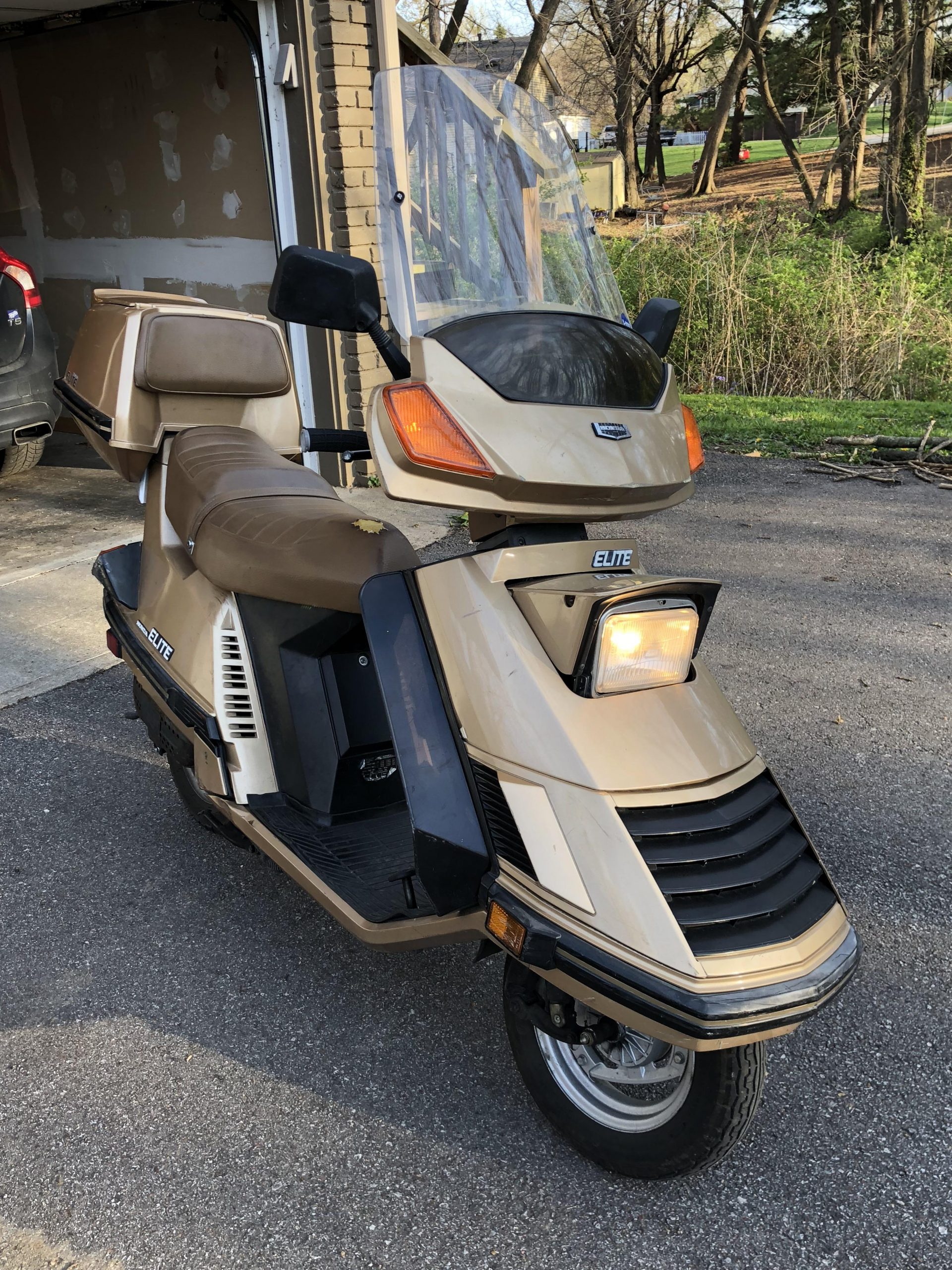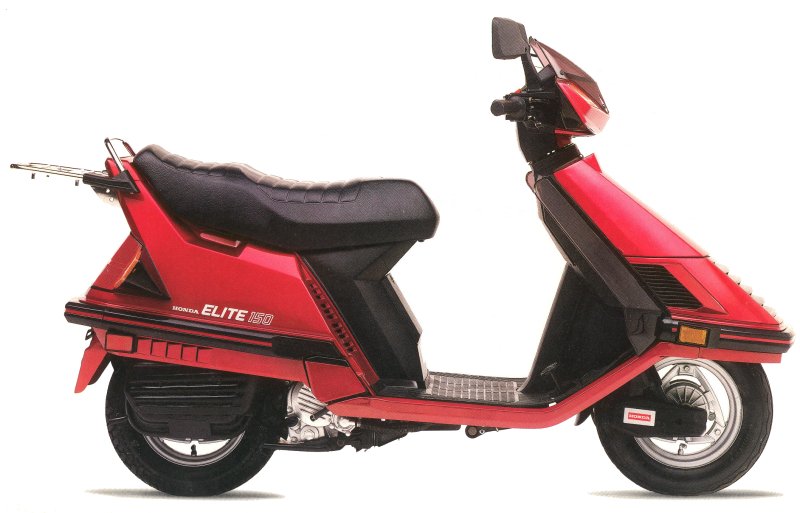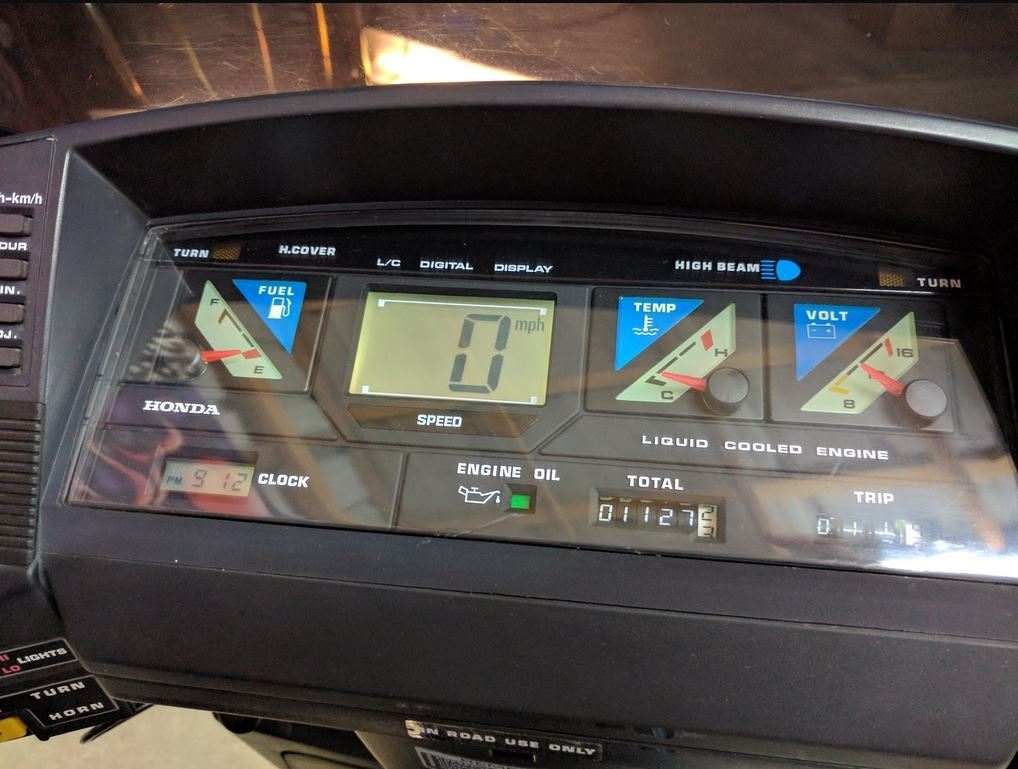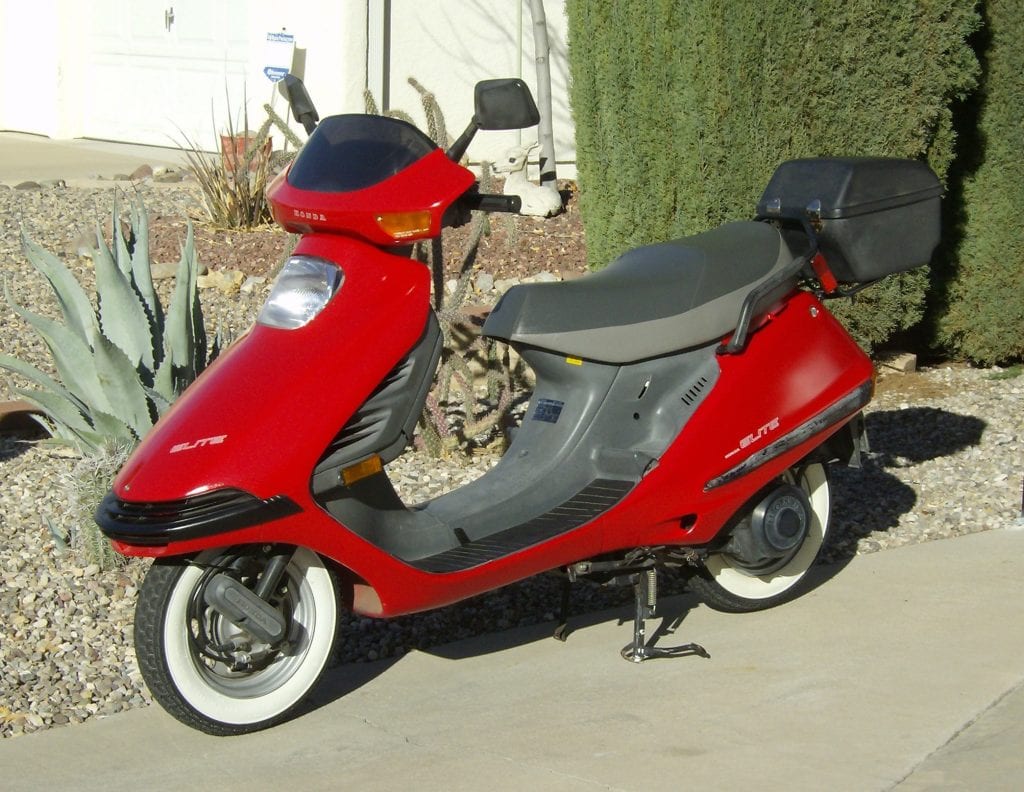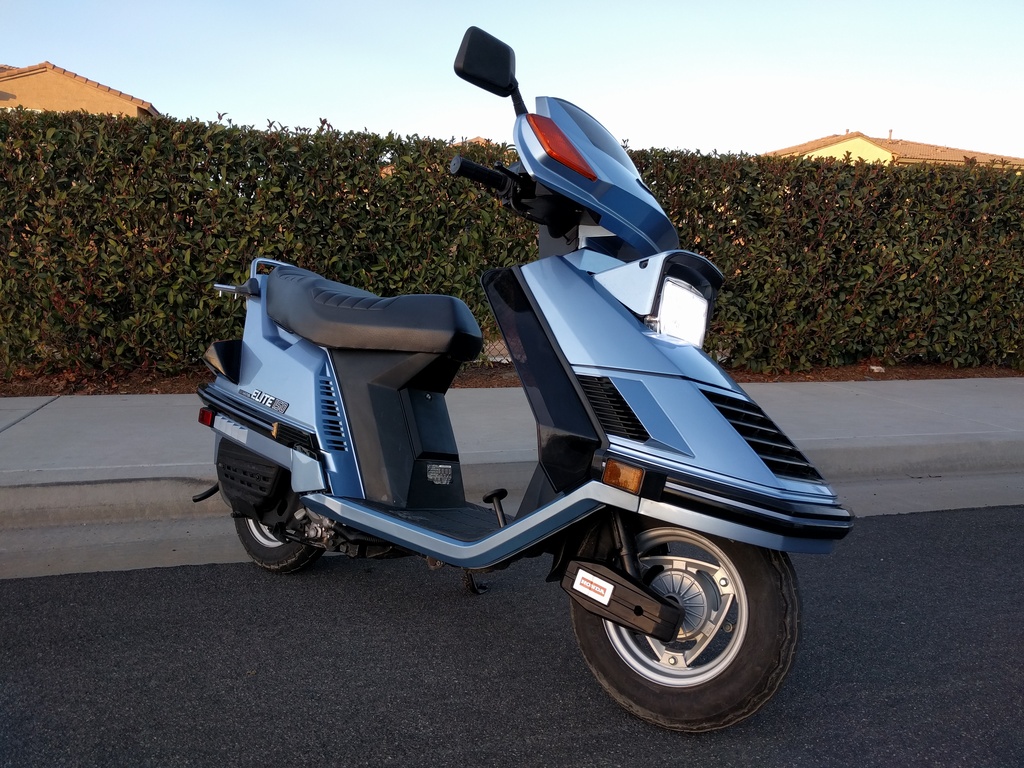HONDA ELITE 125 / 150 (CH125 / CH150)
The Elite 125 / 150 is one of Honda’s best known scooters and perhaps epitomizes the 80’s scooter era more than any other model. First introduced for 1984 (Honda’s second year in the modern scooter business), this mid sized Elite lasted just four years in the USA/Canada, which is surprising given its popularity at the time.
The Elite 125 / 150 was the second largest member of Honda’s Elite family, where it slotted in between the Elite 80 and Elite 250. After 1987, Honda opted to cut the mid-sized Elite 150 and continue selling just the smaller (Elite 50, Elite 80) and larger (Elite 250) models. Perhaps Honda felt the Elite 250 was better large scooter as it has full highway cruising power.
Overseas, Honda sold the CH125 and CH150 in a variety of countries where it was commonly called the Spacy rather than the Elite. The Elite family name was never really used for any Honda scooters outside of Canada and the USA.
Versions
Honda sold four significantly different versions of the Elite 125/150 scooter over its short four year run: Elite 125, Elite 150, Elite 150D and the all new1987 Elite 150.
In 1984, this scooter made its debut in the form of the Elite 125 (CH125). The Elite 125 is capable of 55mph and 65-70mpg. This scooter featured a neat pop up headlight (watch it in action here), making it the first and only scooter ever to use this. It also had some other high tech features like a digital dash (above).
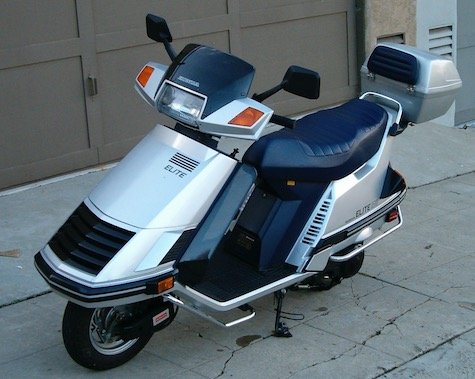
1986 saw Honda drop the regular Elite 150 and only offer the Deluxe version. Presumably, the Deluxe version was more popular.
In 1987, Honda arrived with a new Elite 150 (below right) with more rounded and modern styling. This final Elite 150 shared the same engine as earlier years, but the frame, body panels and many other components were all new. This 1987 model doesn’t seem to have been offered to Canadians.
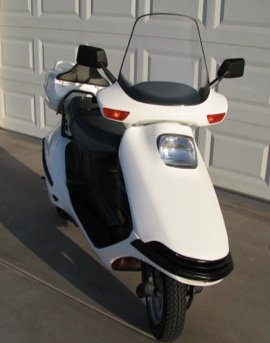
Motors
The Elite 125 and 150 used unique engines from Honda that weren’t shared with any other scooters, aside the versions of this scooter that were sold internationally as the Spacey. Engine displacement is implied in the scooters names, with the Elite 125 offering a 124cc engine and the Elite 150 getting a 153cc mill. That extra 29cc means the larger models go 5-10mph faster and typically do pretty good on backroads. The 60-65 mph top speeds for the Elite 150 aren’t interstate material, but it’s quite a reasonable top speed for most anywhere else.
The Elite 125 and 150 motors are liquid cooled designs that are very reliable once you’ve worked out any kinks that have happened due to years of improper storage. In the case of a blown motor, the 125cc motor can easily be swapped in the 150 and vice versa. The larger Elite 250 motor also bolts in quite easily.
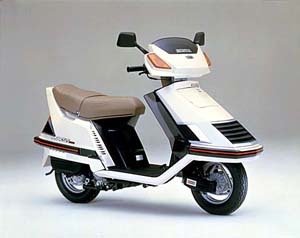
If you’re looking for parts for your Elite, one avenue to explore is the Spacy name, which the CH125/CH150 was commonly sold under in other countries (Europe).
Design and Amenities
All Elite 150’s have a door on the front of the scooter that swings upwards. Unlike the Elite 80, this door unfortunately does not lead to a cavernous storage area. Rather this door exists simply for access to the front mounted radiator and fuses. In models without the headlight there is a small bit of extra space, but this storage area is unfinished and thus not ideal for day to day use. At best, this area is handy for keeping a few tools that you might need in an emergency.
The Elite 125/150 scooters also have an average sized glovebox but there’s no storage under the seat due to the location of the gas tank, thus overall storage is limited. A rear case is a popular option for people who want some decent storage.
The mid-sized Elite used a foot pedal for the rear brake which is rare in modern scooters. This pedal takes a bit used to, but eventually it becomes fairly intuitive to use. However, braking in a panic does remain a bit unsettling. If you find yourself having to make an emergency stop on a wet road, you’ll impulsively want to lower your feet for stability but you can’t because you also need to use your right foot to brake.
The Elite 125 / 150 featured neat vents that direct hot air from the front mounted radiator to your feet. You can open and close these vents as needed. A halogen headlight was also standard. On the Elite 125 and Elite 150 Deluxe models, Honda used a neat digital dash which was pretty fancy for its time and now is a need reminder of the 80’s. The analog gauges found on the regular Elite 150 might be the more stylish setup however.
Discussion
If you are looking to buy an 125 – 150cc Elite, you’re probably going to find a lot more ’85-’86 scooters than ’84 or ’87. If you like the pop up headlight style, get an Elite 150 Deluxe over the Elite 125 because 65mph is quite a bit faster than the Elite 125’s top speed of 55mph. It’s the difference between keeping up with traffic and creating a train of cars in a 55mph zone.
If you’re not lured by the pop up light, the regular Elite 150 is the way to go because the pop-up light is prone to troubles and if you have to leave the headlight up all the time then that detracts from the look and milage. All versions of the Elite 125 / 150 have the nice sized glovebox.
Pros:
- Super comfy seat
- Very reliable
- Liquid cooled
Cons:
- Foot pedal brake takes getting used to
- No underseat storage
Links:
’84 Elite 125 Service Manual – Very useful for working on your Elite 125.
’85 – ’86 Elite 150 Service Manual – Great technical info on the Elite 150.
Elite 125 / 150 Brochure and Ad Scans
MyScoot – Modifying and dissecting Elite 125 / 150 & 250 Engines
MotorscooterGuide Forums – Visit the forum on this site to chat about your scoot.
Elite 150D Ad – Ad for Honda Scooters (showing the Elite 150 Deluxe) with Jim McMahon
Elite 150 Ad – Ad for Honda Scooters (showing the Elite 150) with Sandra Bernhard (Comedian)
Colors:
- 1984: Candy Ruby Red, Light Copper Metallic (Elite 125)
- 1985: Candy Ruby Red (aka Metallic Red), Pleiades Silver Metallic (CH150 only), Nassau Blue Metallic (Deluxe only)
- 1986: Candy Ruby Red, Satellite Blue Metallic
- 1987: Pearl Gleam Red, Pearl Seashell White
Key Specs – 1984 Elite 125
- Engine: Liquid-cooled, OHC, four-stroke 124cc single
- Bore & Stroke: 56.5mm x 49.5mm
- Compression Ratio: 10.3:1
- Power: 9.6hp @ 7500 RPM, 7.0 lbs-ft torque @ 6500 RPM
- Transmission: Honda V-matic variable ratio with automatic clutch
- Ignition: Capacitor discharge
- Starter: Electric
- Final Drive: V-Belt
- Tires: 3.5 x 10 (front and rear)
- Length: 76.4” / 1940mm
- Width: 26.0” / 660mm
- Height: 42.3” / 1150mm
- Wheelbase: 47.2” / 1200mm
- Seat height: 29.9” / 760mm
- Ground Clearance: 4.5” / 115mm
- Dry weight: 216 lbs
- Fuel Capacity: 8.3 litres / 2.1 gallons
- Wheels: 10” cast aluminum
- Front Suspension: Bottom Link
- Rear Suspension: Swing unit, single shock
- Brakes: Drum / Drum
- Spark Plug: NGK DPR7EA-9
- Colors: Light Copper, Candy Ruby Red
- MSRP: $1298
Key Specs – 1985 – 1986 Elite 150 / 150 Deluxe
- Engine: 152.7cc, Liquid-cooled, 4-stroke, OHC engine
- Compression Ratio: 10.1:1
- Bore and Stroke: 58 x 57.8mm
- Cylinder Compression: 184 psi
- Engine Weight: 58 lbs.
- Overall Length: 75.8”
- Overall Width: 25.79”
- Overall Height: 45.79”
- Wheel Base: 47.2”
- Dry Weight: 236 lbs.
- Fuel Tank: 2.1 gallon (8 liter)
- Tires: 3.5 x 10 (front and rear)
- Clutch Type: Automatic Centrifugal clutch, Dry Type
- Primary Reduction: 2.2-0.9
- Final Reduction: 7.318 : 1
- Spark Plug: NGK DPR7EA-9
- Maximum Load: 338 lbs
Key Specs – 1987 Elite 150:
- Engine: 152.7cc, Liquid-cooled, 4-stroke, OHC engine
- Compression Ratio: 10.1:1
- Bore and Stroke: 58 x 57.8mm
- Overall Length: 76.4”
- Overall Width: 25.8”
- Seat Height: 29.9”
- Wheel Base: 47.2”
- Dry Weight: 231 lbs.
- Fuel Tank: 2.1 gallon (8 liter)
- Clutch Type: Automatic Centrifugal clutch, Dry Type
- Tires: 3.5 x 10 (front and rear)

